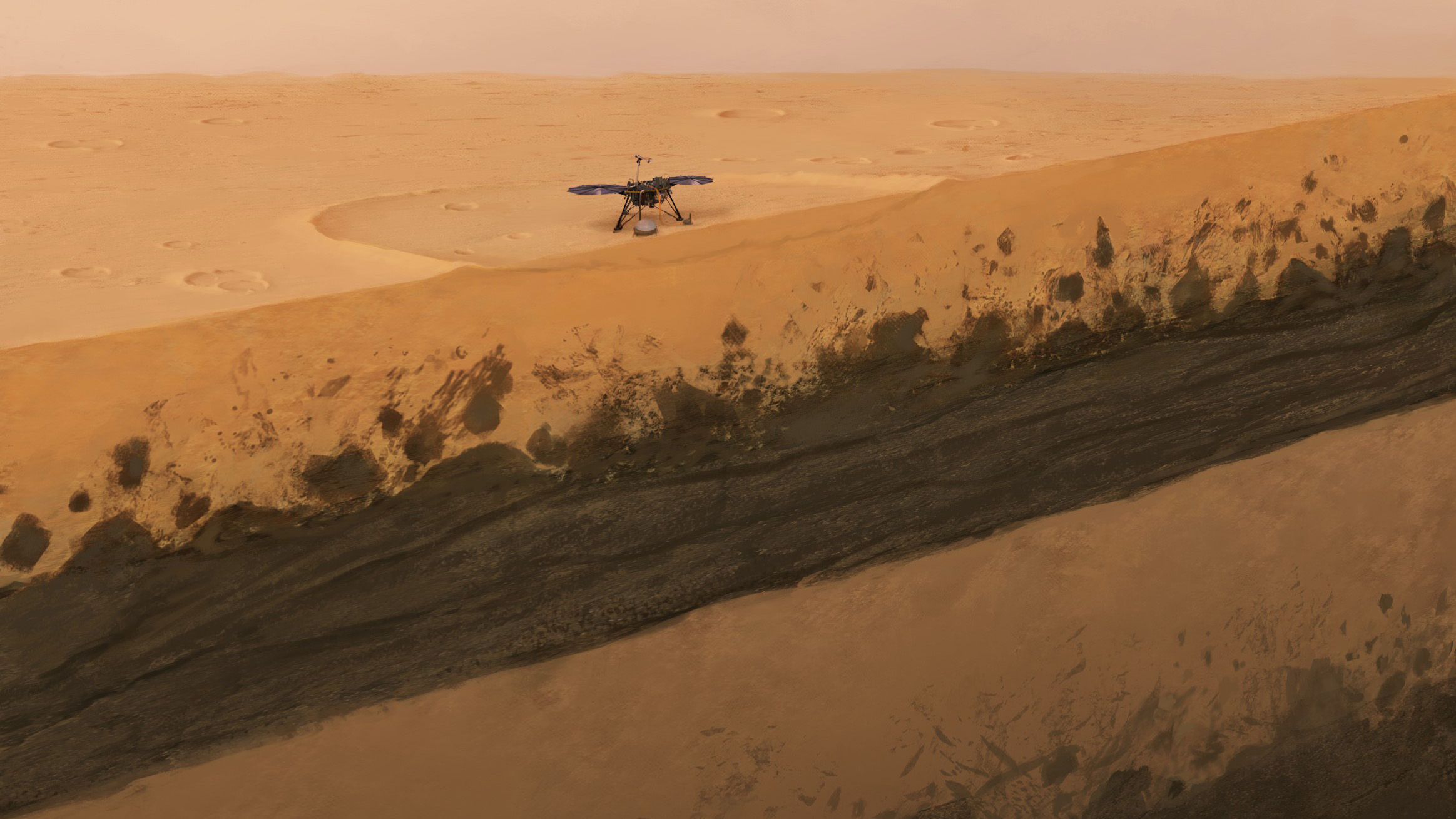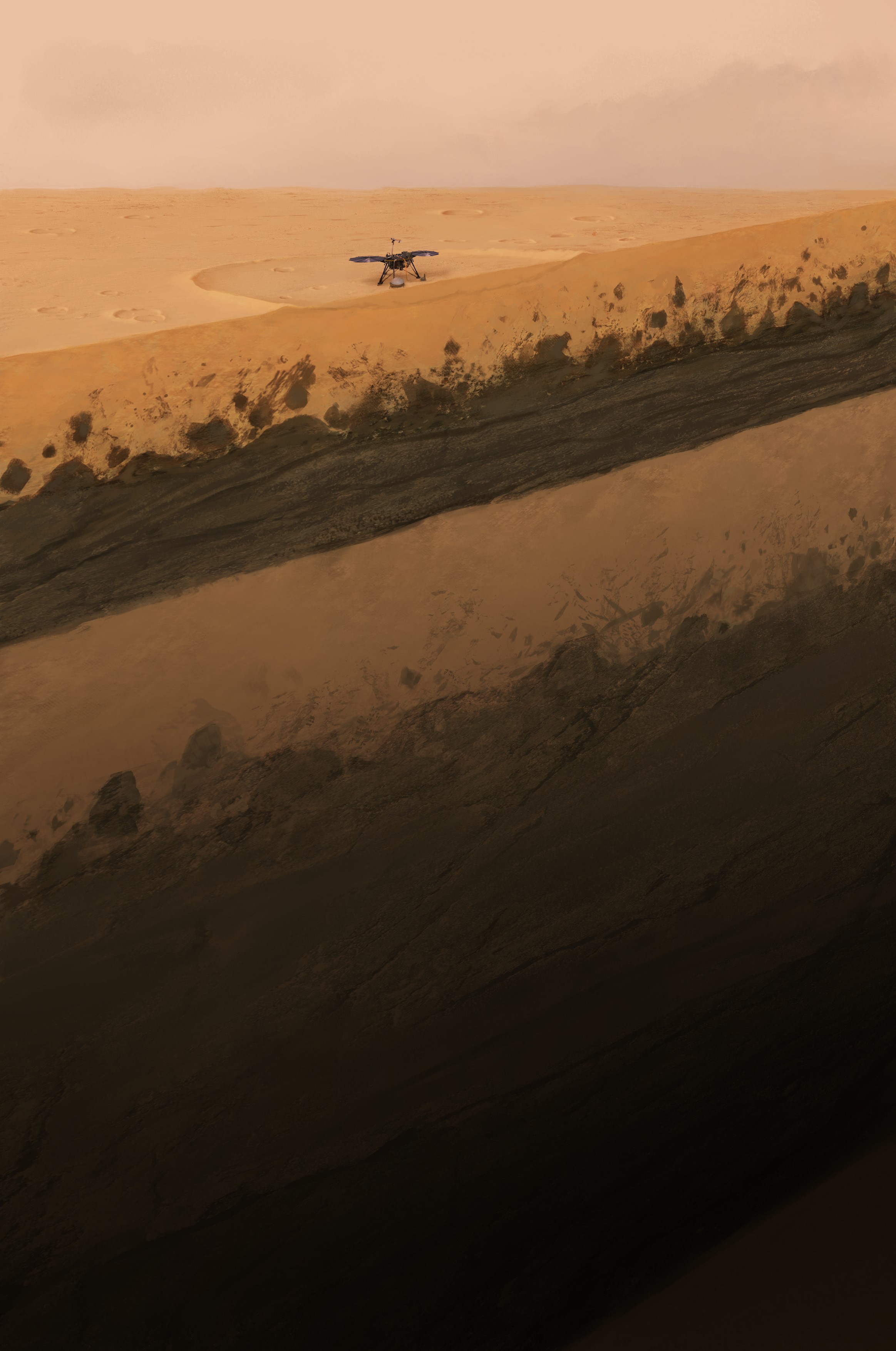NASA Mars lander makes 1st ever map of Red Planet underground by listening to winds
The sound of wind reveals details of Martian subsurface.

Researchers have created the first-ever map of the Martian underground by listening to the sound of wind reverberating through the layers of soil and rock near Mars' equator.
The team used instruments on board NASA's InSight probe, which landed in the flat Elysium Planitia in 2018 to study weak "marsquakes" rippling through the planet. InSight's data has previously enabled scientists to get a rough idea of the size and composition of Mars' core, as well as the nature of its mantle and thickness of its crust.
A new technique developed and finetuned on Earth now for the first time enabled a team led by Swiss geophysicists to use the lander's instruments to peek directly underneath the planet's parched surface and discover what lies within the first 660 feet (200 meters) of its crust.
"We used a technique that was developed here on Earth to characterize places for earthquake risk and to study the subsurface structure," Cedric Schmelzbach, a geophysicist at the Swiss Federal Institute of Technology in Zurich (ETH), and corresponding author of the new paper told Space.com.
"The technique is based on ambient vibration," Schmelzbach said. "On Earth, you have the oceans, the winds, that make the ground shake all the time, and the shaking that you measure at a certain point has an imprint of the subsurface."
Related: NASA's InSight Mars lander 'hears' Martian wind, a cosmic first
Essentially, the commotion on the surface makes the ground vibrate. These minuscule vibrations propagate deep into the subsurface and can be picked up by sensitive instruments.
Get the Space.com Newsletter
Breaking space news, the latest updates on rocket launches, skywatching events and more!
Mars, Schmelzbach said, is much quieter than Earth. There is no ocean on the planet and Mars' atmosphere is much thinner, resulting in a weaker, more feeble wind. On top of that, while on Earth geologists could use countless stations, on Mars, they only have one — the InSight lander.
Yet, listening to the interaction of the Red Planet's winds with the ground underneath its craters and plains revealed the subsurface structure in astonishing detail.
"The resolution gets coarser the deeper we get," said Schmelzbach. "Close to the surface we can resolve layers that are one meter [three feet] thick. But in greater depths it is really a few tens of meters [10 meters = 33 feet]."
The map provides a fascinating glimpse into the past several billion years of Martian evolution. It reveals an unexpected layer of deep sediments as well as thick deposits of solidified lava, all covered with a 10-foot-thick (3 m) blanket of sandy regolith.

The surprising sedimentary layer, the origin of which is still a mystery, is located 100 to 230 feet (30 to 70 m) below the Martian surface, sandwiched between two solidified layers of ancient lava.
"We're still working on how to interpret that and how to date how old this layer is," he said. "But it tells us that probably the geological history at that site is really more complicated than we originally thought and that probably more processes had happened in the past at that place."
The researchers compared the two lava layers embracing this sediment with previous studies of geology of nearby craters. This data enabled them to place the origins of those layers into two important periods in Mars' geological history some 1.7 billion and 3.6 billion years ago.
On top of the younger lava layer, just below the surface regolith, is an approximately 50-feet-thick (15 m) band of rocky material likely stirred up from the Martian surface by a past meteorite impact that then rained back down to the planet's surface.
In the future, the scientists would like to see whether they could stretch their technique a little further and look even deeper, within the first few miles of Mars' crust.
"We have kind of a blind zone there at the moment," said Schmelzbach.
Earlier studies of the planet's core, mantle and crust based on InSight data have revealed surprising differences between Mars and Earth. The two planets are frequently considered solar system twins that up to a certain point shared their evolutionary paths.
Both planets developed abundant oceans of water and rich atmospheres. But then, Mars lost its protective magnetic field, which subsequently allowed the abrasive solar wind, the stream of charged particles emanating from the sun, to gradually strip the planet of its atmosphere, and Mars developed into the hostile world that it is today. Scientists hope that the two planets' geologies may provide some clues to their different paths.
The study was published in the journal Nature Communications on Tuesday (Nov. 23.)
Follow Tereza Pultarova on Twitter @TerezaPultarova. Follow us on Twitter @Spacedotcom and on Facebook.
Join our Space Forums to keep talking space on the latest missions, night sky and more! And if you have a news tip, correction or comment, let us know at: community@space.com.

Tereza is a London-based science and technology journalist, aspiring fiction writer and amateur gymnast. Originally from Prague, the Czech Republic, she spent the first seven years of her career working as a reporter, script-writer and presenter for various TV programmes of the Czech Public Service Television. She later took a career break to pursue further education and added a Master's in Science from the International Space University, France, to her Bachelor's in Journalism and Master's in Cultural Anthropology from Prague's Charles University. She worked as a reporter at the Engineering and Technology magazine, freelanced for a range of publications including Live Science, Space.com, Professional Engineering, Via Satellite and Space News and served as a maternity cover science editor at the European Space Agency.









